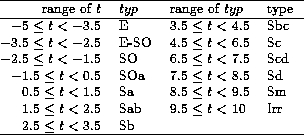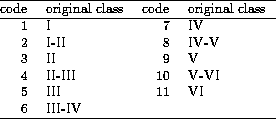
Table 3: Output morphological type codes
Morphological types (E, SO, Sa ... Sm, Irr) have been entered in LEDA as an internal numerical code. This code will be treated as a continuous quantity.
Obviously, the definition of what is a given morphological type is not the same for each astronomer. We thus adopted the RC3 type code system as a reference one and converted to it all type codes of others catalogs. A rms dispersion can be attached to each type code for each reference allowing us to calculate a weighted mean morphological type code t and its actual uncertainty st. In addition, some features have been coded in LEDA: ring, bar, interaction (or multiplicity), and compactness. These features are simply given as a flag R, B, M for the first three parameters and C or D for the last one (C for compact and D for diffuse). Further, the numerical code t and the features above are used to produce a literal Hubble type typ (e.g. SBa). The ranges of definition are in Table 4 (click here).

Table 3: Output morphological type codes
When the morphological type is uncertain (![]() ) a rough type is
used with a question mark (e.g. E? or S?).
) a rough type is
used with a question mark (e.g. E? or S?).
The histogram of mean morphological type codes is given in Fig. 2 (click here). These type codes are available for 60130 galaxies.
![]()
Figure 2: Histogram for morphological type codes
The luminosity class introduced by Van den Bergh (1960) has been numerically coded between 1 and 9 with the extension introduced by H.G. Corwin (SGC, 1985) between 9 and 11. The codes are given in Table 5.

Table 4: Luminosity class codes
This code is treated as a continuous parameter. We calculated the mean luminosity class lc and the actual uncertainty slc by giving the same weight to each reference.
Luminosity class codes and morphological type codes are used to calculate the luminosity index lambda according to de Vaucouleurs et al. (1979).
![]()
where lcc is the luminosity class corrected for inclination
according to the relation:
![]()
where logr25 is the axis ratio defined in Sect. 6 and
c is a parameter depending on the morphological type code t (c=2.0
for ![]() and c=2.0-0.9(t-5), otherwise).
and c=2.0-0.9(t-5), otherwise).